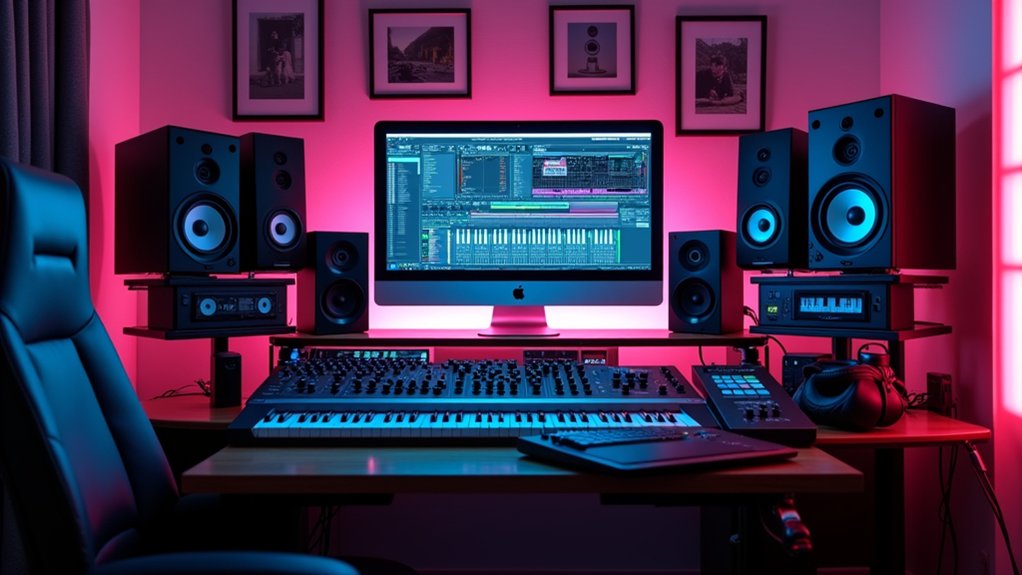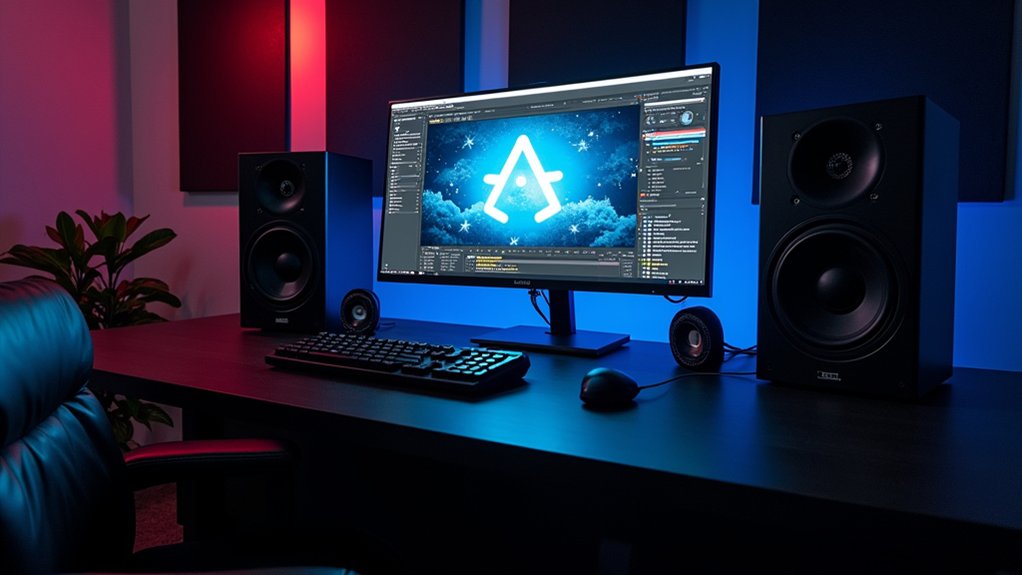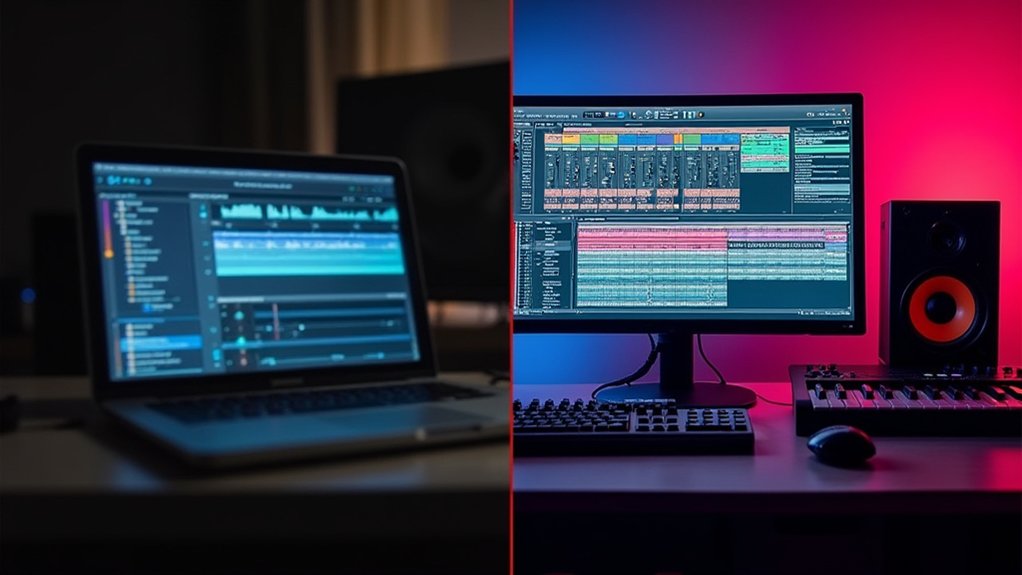FL Studio stands out for its efficient, intuitive workflow and robust suite of native production tools, with lifetime free updates enhancing long-term value. Its highly customizable environment accelerates both novice and experienced producers’ sessions, though the lack of in-depth built-in tutorials and a narrower native plugin range may limit advanced sound design options. Flexible pricing tiers cater to diverse needs, and shifting users benefit from strong community support. Discover how these strengths and limitations impact your studio decisions.
Key Takeaways
- FL Studio offers an intuitive interface and workflow, making it accessible for both beginners and experienced producers.
- Lifetime free updates provide long-term value and access to the latest features without extra cost.
- The included suite of native plugins is robust but narrower compared to some competitors, potentially limiting advanced sound design.
- Lack of comprehensive built-in tutorials may make mastering advanced features challenging for new users.
- Multiple editions and seasonal discounts make FL Studio flexible and affordable to fit various production needs and budgets.
Key Advantages of FL Studio
FL Studio distinguishes itself through an intuitive user interface, streamlining the workflow for both novice and experienced producers. As a Digital Audio Workstation, it features a clearly organized step sequencer, a versatile mixer, and advanced audio recording, making music production efficient at every stage. The producer edition enhances this with access to a robust suite of native plugins, offering a broad spectrum of presets and deep sound-sculpting capabilities. Customizable layouts and project templates allow users to save frequently used settings, optimizing session setup and productivity. The availability of a feature-rich, unrestricted trial version further supports experimentation with various tips and tricks, enabling users to explore the full range of FL Studio’s capabilities before purchasing. This adaptability positions FL Studio as a leading choice for all skill levels. Additionally, mastering tools like Slice X and Fruity Slicer for precise and efficient sample manipulation can significantly speed up your workflow, allowing producers to create new patterns swiftly.
Drawbacks and Limitations
Several notable limitations accompany FL Studio’s otherwise streamlined workflow.
The navigation can be intimidating, especially for newcomers, as the absence of built-in tutorials complicates the discovery of core features and essential tools. The production process may become inefficient when users must rely on external resources to learn fundamental operations.
Although the piano roll is highly regarded, FL Studio’s native plugin selection is narrower than some competitors, potentially impacting the depth of sound design.
Advanced users may find the lack of customizable features—such as Max For Live integration—restrictive, limiting the DAW’s flexibility.
Additionally, the Patcher device, while functional, offers less versatility compared to similar modular tools in other platforms, imposing clear limitations on complex routing and effect chains within the sound creation workflow.
FL Studio’s support for VST and AU plugins provides a vast selection of third-party options, enhancing creative possibilities despite its native plugin limitations.
Pricing, Editions, and Updates
A range of edition tiers grants users flexibility in selecting a version that aligns with their production needs and budget.
FL Studio’s pricing structure spans from the entry-level Fruity Edition to the extensive All Plugins Edition, each catering to different workflow requirements. The Producer Edition offers advanced features, while the All Plugins Edition enhances sound design with full playlist access and an extensive plugin suite.
Updates remain a strong value proposition; users benefit from lifetime free updates, ensuring ongoing access to new features and improvements at no extra cost. The trial version, though limiting project reopening, allows users to assess suitability before purchase.
- Multiple editions scale by features and price.
- All Plugins Edition maximizes sound design capability.
- Lifetime free updates increase FL Studio Worth.
- Seasonal discounts occasionally reduce pricing.
When evaluating FL Studio’s editions, consider a laptop with essential features such as a robust processor, ample RAM, and SSD storage to support smooth music production and efficient software operation.
Learning Curve and User Experience
While the digital audio workstation market presents a variety of complex interfaces, FL Studio distinguishes itself through an intuitive design that accelerates workflow, particularly for novice producers. The streamlined interface delivers a positive user experience by minimizing unnecessary complexity and promoting easy navigation.
Working in FL Studio, users benefit from customizability options such as adjustable layouts and project templates, allowing for tailored workflows that fit individual production styles. The learning curve for basic operations remains gentle, assisted by short tutorials that foster quick onboarding. Familiarization with FL Studio Interface can significantly enhance creative workflow and technical proficiency, aiding users in organizing sounds and constructing patterns efficiently.
However, the absence of extensive built-in tutorials can challenge users seeking mastery of advanced features, often necessitating external resources. Overall, the emphasis on user-friendly design and adaptable settings positions FL Studio as a sound-oriented platform suitable for both beginners and evolving producers.
Transitioning From Other DAWS
Although digital audio workstations share foundational concepts, shifting from platforms like Ableton or Logic Pro to FL Studio demands adaptation to its distinct workflow and interface.
The change process is heavily influenced by a user’s familiarity with core music production techniques, but Fruity Loops exhibits unique design elements. Significantly, its Step Sequencer-centric pattern creation and channel rack organization differ from the linear arrangements of other DAWs. One crucial aspect is the need to define plugin location and manage plugin paths to ensure seamless integration of new tools and maintain workflow efficiency.
However, experienced users can leverage their existing knowledge, streamlining the process of making music with FL Studio. Extensive learning resources and a robust user community further ease this change.
- Identify parallels between familiar DAW tools and FL Studio equivalents.
- Invest time in mastering the Step Sequencer for rapid beat construction.
- Utilize community tutorials to accelerate workflow adaptation.
- Explore the Piano Roll for advanced melodic editing and automation.
Frequently Asked Questions
Is FL Studio Good for Film Scoring?
FL Studio offers robust MIDI capabilities and efficient workflow tools for film scoring, with flexible audio libraries and sound design options. While it lacks some specialized features, its intuitive interface enables streamlined composition and arrangement for cinematic projects.
Do Any Pros Use FL Studio?
Many professionals utilize FL Studio due to its robust features, frequent updates, and versatile native plugins. The active FL Studio community further enhances workflow and sound design possibilities, making it a staple in high-level music production environments.
Do Any Big Artists Use FL Studio?
Many prominent artists leverage FL Studio features, such as advanced FL Studio plugins and customizable FL Studio templates, to streamline their workflow. Access to thorough FL Studio tutorials further enhances their sound design, facilitating chart-topping track production in professional environments.
When You Buy FL Studio, Is It Permanent?
Upon purchase, FL Studio grants perpetual license duration, ensuring permanent ownership rights. Users benefit from lifetime software updates without recurring fees, distinguishing it from subscription models and supporting a consistent, workflow-focused environment for sound design and music production.
Conclusion
FL Studio offers a robust suite of features prized by electronic producers for its intuitive workflow, flexible piano roll, and lifetime free updates. While its mixer routing and audio recording may not match every competitor, its rapid beat-making capabilities and broad plugin support make it a solid choice. Ultimately, whether FL Studio is worth it depends on a producer’s workflow preferences, genre focus, and willingness to adapt to its unique interface and strengths within a professional audio environment.




